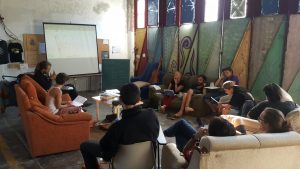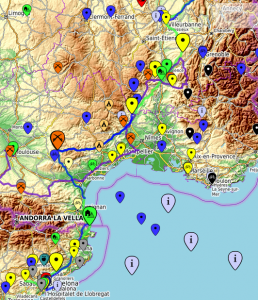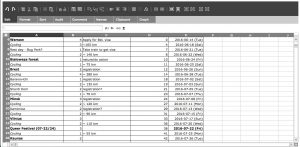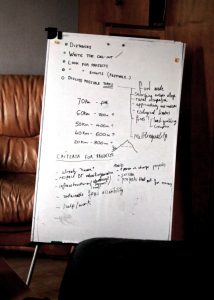Cycling across different countries in a large group visiting projects on the way requires a lot of preparation. Most projects would be totally overwhelmed by a group of up to 50 cyclists arriving without announcement, and people who want to join or leave on the way need to make their travel arrangements in advance, so a day-by-day schedule of the tour is usually already planned several months before the tour starts. In addition, the communal equipment needs to be repaired, completed and transported to the starting point of the tour, papers need to be written printed that contain information that is important on the way, and promotion material like posters, flyers and the website need to be updated and distributed. In times when the Biketour was still cycling to the Ecotopia Gatherings and was thus supported by the big network of activists who were planning to attend it, the tour was sometimes prepared to such an extent that local people cycled each segment of the tour in advance, selecting the best roads and camping spots.
Coordinators vs. Open Group
In the past, the Biketour has often been prepared by one or two “coordinators”. They were keeping an overview over the preparation process and did most of the work. Sometimes there were additional structures like regional coordinators for different parts of the route. Often, we applied for funding to pay the coordinators to be able to work on the preparation full-time.
Usually, it was hard to find anyone who would be willing to take on the huge responsibility of becoming a coordinator. In 2013 though, when the tour was planned to start in Berlin, we received more than 10 applications and had to select two of them, as that was a limitation imposed by the funding that we had applied for. Because this created dynamics quite similar to the capitalist competitive labour market, and because the concept of having two coordinators anyways contradicts the way we usually do things on the Biketour (where we try to share all responsibilities among everyone), a proposal was brought up to get rid of the two funded coordinator positions and instead try to prepare the tour as an open group where many people take on little tasks decentrally and coordinate with each other online.
 In 2015, this approach of an open preparation group was tried for the first time, and it turned out to work not so well (one person did most of the work alone). We could think of two reasons for this: Either only few people have the time to prepare the Biketour in their free-time, or the Biketour community is not yet used to the new approach and first needs to learn that it is necessary to contribute before joining the tour. During the tour in 2015, it was very clearly communicated that everyone’s initiative is needed to organize 2016. Since then there is a slowly growing open group preparing the Biketour.
In 2015, this approach of an open preparation group was tried for the first time, and it turned out to work not so well (one person did most of the work alone). We could think of two reasons for this: Either only few people have the time to prepare the Biketour in their free-time, or the Biketour community is not yet used to the new approach and first needs to learn that it is necessary to contribute before joining the tour. During the tour in 2015, it was very clearly communicated that everyone’s initiative is needed to organize 2016. Since then there is a slowly growing open group preparing the Biketour.
Decision-making structure / Bt-Org list
In addition to the open General Biketour mailing list and the semi-open participants lists for each year, we are using a bunch of other online tools. Most of the communication is happening via a chat-platform and regular online-voice-meetings.
There is also one closed mailing list called Bt-Org. Anyone who is interested in being involved at making decisions about future Biketours can be added to the Bt-Org list, and currently, there are around 50 people on it (although many of them are former coordinators and participants who still receive the e-mails but stay silent most of the time). The Bt-Org list is the main communication platform during the preparation of the tour. Even when the preparation group is using other means of communication (for example Skype or physical meetings), all information should always be shared with the Bt-Org list, for documentation purposes and to make it easy for people to get involved.
While during the tour, decisions are made by the participants by consensus, it is impossible to check for consensus among the participants before the tour, as it is not even clear who is going to participate. That is why during the preparation of each Biketour, decisions are made by consensus on the Bt-Org list. As there is usually only a small group of people really active on Bt-Org each year and most people are silent, we are currently using the following decision-making procedure:
- Bring up topic for discussion
- At a point where no new opinions have been brought up for 7 days, formulate a proposal and send it around with “Check for Consensus” in the subject, mentioning a deadline of 7 days to raise any concerns
- If no one objects within 7 days, the decision is made
Usually all decisions that have been made by the Bt-Org list can be overridden during the tour by the actual participants. The only exception are the Participation Guidelines. They are the basic values of the Biketour and are rediscussed by the Bt-Org list each year. People who are thinking about joining the tour are expecting and relying on these values to be in place, so they can not be changed even when there is a consensus among the participants of the tour at any given point. Most of the Guidelines are phrased in quite a broad way, so it is up to the tour to decide how to implement them.
Once or twice a year, a meeting (Autumn, Winter or Spring Meeting) is organized where interested people come together to discuss about the upcoming tour and the Biketour in general. The outcome of the meeting is usually a list of proposals that are sent to the Bt-Org list for feedback.
Preparation process
The following things need to be prepared for a Biketour to happen.
Route
 Deciding on the route can be a difficult process, as there are circular dependencies. In order to decide on a route, we need to know which projects can host us, but projects need to know at what date we will arrive in order to find out whether they can host us, and in order to predict the date, we need to have the route decided.
Deciding on the route can be a difficult process, as there are circular dependencies. In order to decide on a route, we need to know which projects can host us, but projects need to know at what date we will arrive in order to find out whether they can host us, and in order to predict the date, we need to have the route decided.
The first step is to select a rough region where the tour is happening. It is really helpful to have the region for the next year already decided before the start of each tour, as it enables us to mention it when we talk to people we meet during the tour (so that they can already think about whether they want to join us next year), and it gives the participants a more clear image of the future and thus more motivation to get involved in the preparation of the next year. It also makes it easier to plan who should take the equipment where at the end of the tour. There are different criteria that can be taken into account for deciding on the region:
- Is there any interesting political movement happening anywhere that we would like to join?
- Where has the Biketour not been for a long time? (Check out the “Countries” page on the Wiki.)
- Which region is easy to access for people in countries where we have cycled in the previous year? (Often people meet us on the way and want to join us the next year.)
Once the region is decided, a call-out can be sent out that searches for projects that share our values and can host us or are interested in our visit. The call-out should be sent over multiple channels, a list is maintained on the “Where to announce” Wiki page. Previous call-outs can be found on the Biketour website.
After sending the call-out, many suggestions and invitations will come in, and we collect them all on a map (on https://pad.facilmap.org/) and start to ask them whether they generally have the capacity and interest for our visit during any time of the summer. An e-mail template for this can for example be found on the “E-Mail templates 2016” Wiki page. We mark on the map when we get positive or negative responses. We need to clarify the following things with the projects:
- We will be around 20–40 people (12–24 tents), can camp or sleep inside
- We don’t pay for sleeping (apart from a small donation to cover electricity and water costs), but instead offer to help out
- If they cannot host us, we are also interested in just passing by to speak to them
If they are generally interested, it is good to clarify the following things
- We can either use any existing kitchen equipment or need to make a fire in the Rocket Stove. Is that acceptable for them?
- Is there drinking water?
- Is there electricity and internet? (Good to know if we can plan the route for the next days there.)
- Can we publish on our website that we are sleeping there?
- Where exactly is the project and how can we get there?
- Who can we call if we get lost or something changes short-term?
 Once we have an overview over where the interesting projects are and which ones can host us, we can make a first draft of a day-by-day plan, where we hypothetically write a list of how many days we would like to sleep where and calculate the distance and thus the number of cycling days between those places. Using a spreadsheet (for example on https://calc.rankenste.in/), we can then calculate the dates automatically. This gives us a rough overview about the dates when we will be in what project, which we can let the projects know. What follows then is a lot of fine-tuning, where some projects won’t have the time to host us on those specific dates or new options come up and we need to shift some days around, until we have created the final day-by-day plan.
Once we have an overview over where the interesting projects are and which ones can host us, we can make a first draft of a day-by-day plan, where we hypothetically write a list of how many days we would like to sleep where and calculate the distance and thus the number of cycling days between those places. Using a spreadsheet (for example on https://calc.rankenste.in/), we can then calculate the dates automatically. This gives us a rough overview about the dates when we will be in what project, which we can let the projects know. What follows then is a lot of fine-tuning, where some projects won’t have the time to host us on those specific dates or new options come up and we need to shift some days around, until we have created the final day-by-day plan.
In the cities, there are usually many different projects and groups to visit. There it is good to find a fixed sleeping place for all the nights and arrange meetings with projects and groups during the days. Other things that can be prepared for the cities are actions and info events.
 For the calculation of the cycling days, it is important to consider different circumstances, like the quality of the roads, the shape of the terrain, the climate, and the length of the days. Smaller roads are slower because they have worse surface and even in flat areas they can go up and down a lot. When it’s really hot, many people prefer to take a long break around noon, so less distance can be cycled. On an average day in average climate in a flat area, the maximum distance per day should be around 70 km. The maximum number of consecutive cycling days should be 3. It can be good for the group to plan in wild-camping rest days, where workshops and group processes can happen without distraction from any projects.
For the calculation of the cycling days, it is important to consider different circumstances, like the quality of the roads, the shape of the terrain, the climate, and the length of the days. Smaller roads are slower because they have worse surface and even in flat areas they can go up and down a lot. When it’s really hot, many people prefer to take a long break around noon, so less distance can be cycled. On an average day in average climate in a flat area, the maximum distance per day should be around 70 km. The maximum number of consecutive cycling days should be 3. It can be good for the group to plan in wild-camping rest days, where workshops and group processes can happen without distraction from any projects.
What can be difficult to decide is on which end of the suggested route the tour should start and on which end it should end. Two things should be taken into consideration:
- Usually it is more important to have a bigger group at the beginning of the tour than at the end, as the beginning is where the group needs to work out how to function, which can be really exhausting when there are not enough people to fulfill the daily tasks. Thus the start of the route should be as easy to access as possible, also keeping in mind that most of the time, most participants will come from Central Europe (usually a lot of people from Germany and Britain).
- The climate and length of days need to be taken into consideration. In southern regions, it is too hot in the middle of the summer, while in northern regions, it is too cold in the beginning and end of the summer. In the north, the days are very long in the beginning of the summer, which can take away the stress of having to get up early.
The day-by-day plan should be finished at least two months before the start of the tour, as people need to book their bus and train tickets.
Promotion / Artwork
The Biketour and its details need to be announced on different channels. For this, the following kind of promotion materials needs to be created (and probably translated into local languages):
- Web artwork, graphics and route sketches to be used on the website, the Facebook page and on other places on the internet
- Flyers, posters and/or stickers to be distributed physically
- Announcement texts with detailed information about the route (and visas, public transportation, etc.) to be spread online
Other types of artwork that can be produced are videos (like the really cool “Beyond Borders” 2 minute video from 2013), t-shirts, banners/flags to put on the bikes, and a booklet like this.
On the “Where to announce” Wiki page, we collect places both on- and offline where the tour can be advertised. Online it can be useful to additionally find sites that are related to the theme of the particular year (for example in 2012, the tour was announced on several websites related to the Degrowth movement). Offline it can create a lot of outreach to send flyers and posters to social centres by post, or even to make info presentations there (for example during weekly people’s kitchens).
Equipment
The communal equipment (mainly 3 trailers, some pots and other kitchen equipment) needs to be stored, repaired and completed over the winter. A detailed list can be found on the “Equipment” Wiki page.
The equipment has to be transported to the starting point of the tour. Often, people change their plans, so it is better to have it there early rather than relying on someone who promised to join the tour at the start and bring the stuff. There are several ways to transport the equipment:
- Find someone to cycle it there!
- Send a call-out to the Biketour mailing list, Facebook page, or to any other of the resources listed on the “Where to announce” Wiki page. Often someone is going by car or train and can take some of the stuff.
- Pay a bus driver to load the stuff and have someone collect it in the city of destination
- Find a ride-share on websites like Blablacar and ask them if they can take the stuff
The following documents can be helpful to be printed out to bring on the tour. It is always good to bring multiple copies, as things easily get lost. It can also be nice to laminate the documents.
- The day-by-day plan, with some space for people to sign in to become the project coordinator / day facilitator
- The list of projects, with contact details (phone number, name of contact person), directions (GPS coordinates are also useful) and a summary of what has been communicated with the project. It can also be helpful to have a small map of where each project is located.
- Translations of non-vegan ingredients (see the “Translations” Wiki page)
- Photo-sharing list (a template is on “File:Photo sharing.odt” on the Wiki)
- The booklet if there is one





